A Rabbit Hole into 15th-Century Brocade Tablet Weaving
Bhakail Yule A&S Championship
December 9th, 2023
A.S. LVIII (58)
Competition Connection: For this year’s A&S Championship at Yule, the theme was to create an item specific to a Persona (it need not be your own); the more specific the better. As my persona is a 16th-century Icelandic Viking displaced to Denmark during the rule of King Frederick II, there wasn’t much I could do in the way of tablet weaving that would work since tablet weaving was slowly phasing out of popularity in that portion of the world. So I set my sights on a different gentle; my significant other, Orso Luca di la Licata—a 15th-century Sicilian Mercenary (a Condottiero to be precise).
Trim was one of the most common uses for tablet woven bands, and thus began the rabbit hole of research as I tried to find a historic tablet weaving pattern that would be feasible for Orso to have somewhere on his garb. I discovered that by that point in history, almost everything tablet woven was brocade.
Since I’ve never done brocade tablet weaving before, I didn’t know much about the technique other than “Oo Shiny!” and “Wow that looks complicated.” I did a bit of digging and asked Magnifica Arabella de Mere for guidance. She provided me with her “Intro to Brocade” class handout and introduced me to another tablet-weaving Laurel who specializes in brocade, Maestra Ellisif Gydasdottir.
After discussing my dilemma of finding a pattern with Maestra Ellisif, she suggested I check out Cod. Pal. Germ. 551. A manuscript from Nuremberg, Germany in 1471 containing around three hundred brocade tablet weaving patterns written by the Sisters of St. Clare’s, a convent in Nuremberg, Germany.
Historically speaking, this is the earliest account of written patterns for tablet weaving. Currently, this manuscript is being housed at the Library of Heidelberg University in Germany. They have kindly uploaded high-resolution scans of the entire document free for public access on their website.
Persona Connection: “But Jakob, Orso is Italian. How in the world does it make sense for him to be wearing trim from a pattern that came from Germany?” I’m so glad you asked! Let’s take a look at some of the specific details of Orso’s persona.
Being a Mercenary, Orso didn’t stay solely in Sicily. During the 15th century, Italy was constantly at war within itself as the country was made up of many City-States. Florence, Venice, and Naples all hired mercenaries to augment the ranks of their armies.
One of the main ongoing conflicts that was a huge source of income for Orso and other Condottieri at the time was the Wars in Lombardy. These were a series of conflicts that affected the entirety of Italy from 1423-1454. Orso being born in 1425 well… you can guess he was thrown right into the thick of it and had plenty of opportunities to excel in the mercenary trade.
And excel he did! The conflicts ended in 1454 with the Treaty of Lodi, and Orso, at the ripe old age of 29, still needed work and something to do. So he shifted gears from wars between City-States to jobs such as security for wealthier clients like merchants and minor nobility. It was one such job, being a bodyguard to a rather wealthy indigo merchant, that landed him on the road to Southern Germany. Orso would most likely finish out his career in Germany, and he would be around 46 when Cod. Pal. Germ. 551 was written.
Project Details: I stumbled across a lovely article diving into the history and provenance of the manuscript; at the bottom of the article were photographs of sample pieces. I was immediately drawn to this very simple and small leaf pattern motif.
Maestra Ellisif has worked with this manuscript before, and was able to help me pinpoint which pages of the scans I needed in order to transcribe the pattern I decided to use.

(Left. Sample of a way to transcribe the patterns, and a sample of what it would look like finished.
From: Woven Bands, Medicines and Recipes: Cod. Pal. Germ. 551. By Ute Bargmann)
This particular pattern is found on pages 51-52 in the manuscript. (51r and 51v). Pattern writing wasn’t an exact science back then so there are challenges that come with trying to follow a pattern like this.
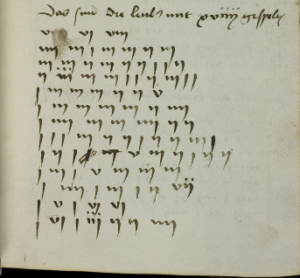
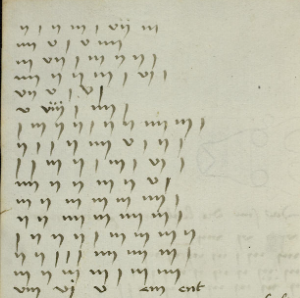
(Above, Pages 51-52 of Cod. Pal. Germ. 551. Specifically cropped to focus on the leaf pattern for this project).
First, you need to transcribe it from the notation to a graph to see what the pattern will look like. This helps with correcting mistakes (trust me there are several). From the work that Maestra Ellisif has done on this manuscript, she’s learned that there are at least 4 different types of handwriting/notation styles, tons of errors, and the ways they wrote the patterns changed throughout the manuscript. Not to mention any text is in medieval German calligraphy. In short, it’s a hot mess.
(Below. A glimpse of the tedious yet chaotic process of transcribing and correcting the pattern.)
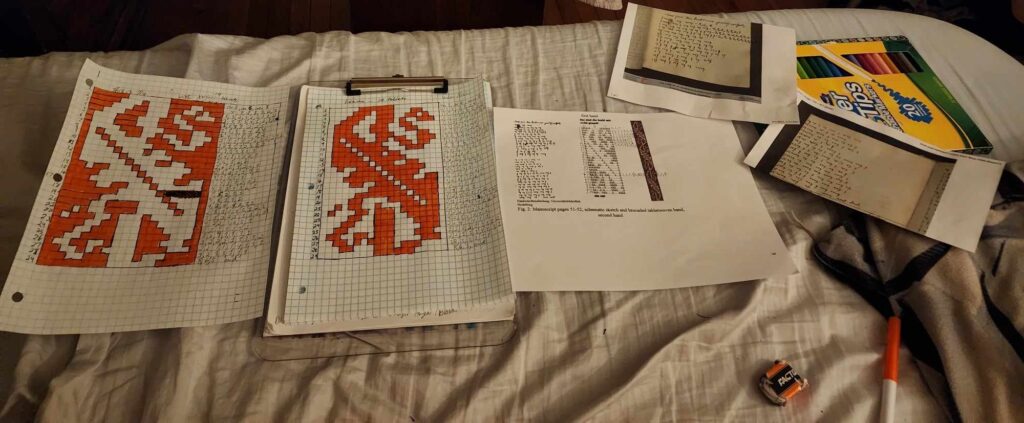
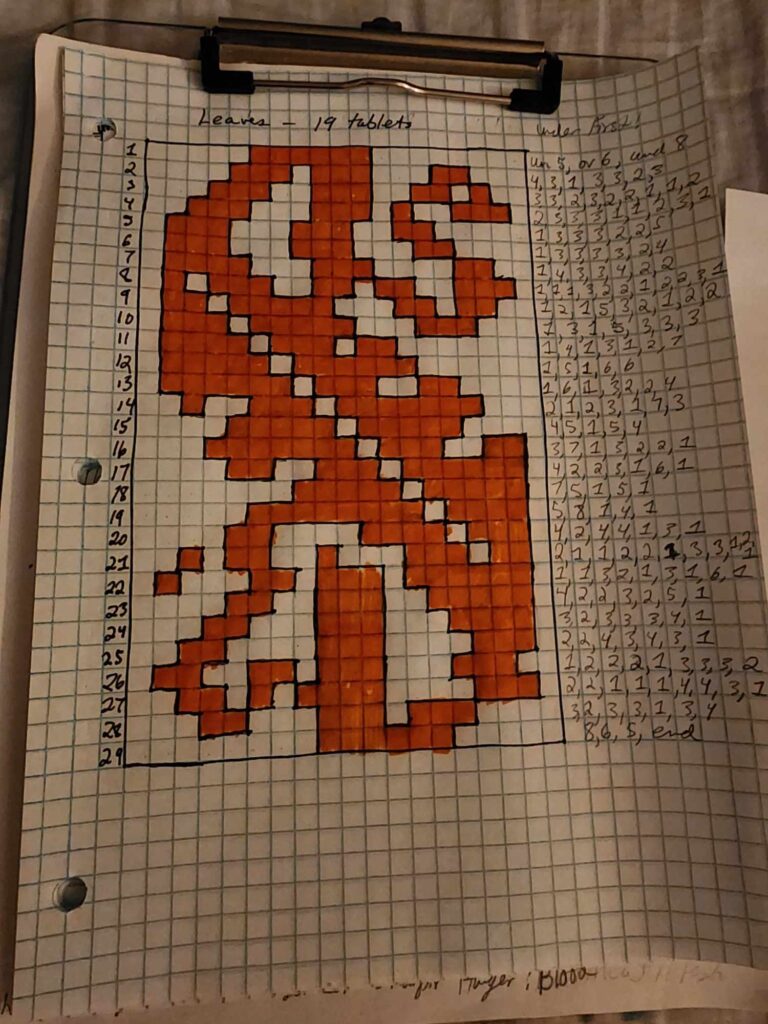
(Right. Final copy of the transcribed brocade pattern.)
Once I finished the transcription, I gathered my materials to start weaving. Like most tablet weaving patterns, this one is read from the bottom up. You begin reading left to right, however, as you weave you’ll alternate between left to right and right to left as the weaving goes along.
This technique works by using a second shuttle loaded with a thicker thread in a contrasting color. This thread is called the brocade weft while the main warp and weft are called the ground weave. You create a secondary shed for the brocade weft by weaving over and under the warp threads as instructed by the pattern. In this pattern, a white square signifies going under the threads on a card, and the orange squares signify going over the threads on a card.
Because it requires double the shuttles, it takes double the time. The rule of thumb for how long a brocade pattern takes is about 1 inch/hour of weaving. In this pattern, 1 inch is equal to 1 and a half repeats, or one and a half leaves). This is why I only have about one yard finished out of the three yards I warped onto my loom.
In the 15th-Century almost all brocade was done with gold thread. So as is period, this time I decided on dark green silk for the ground weave (or background) in size 60/2 and gold silk for the brocade motif in size 20/2.
Materials Used:
Materials Used In Period:
- Hand-dyed Silk Thread: – Thinner for the ground weave
– Double the Thickness for the Brocade thread - 2 Shuttles made of bone or wood
- Wooden Beater Sword
- Wood, Bone, Leather, or Pasteboard Cards
- A Backstrap, Box, or Osberg Loom
Materials I Used:
- 60/2 Silk Thread in Dark Green
- 20/2 Silk Thread in Gold
- Bone Shuttle/Beater
- Wood Shuttle/Beater
- 3-yard Inkle Loom
- 23 Cardboard Tablet Weaving Cards
- Cattle Bone Bonefolder
- Thread Snips
- Toothpicks
- Knitting Stitch Holder
Like all projects, this one was not without hiccups. Besides the usual “Oops my warp thread snapped,” Or “Crap! I ran the wrong shuttle through the brocade weft!” There was a minor pattern change that needed to be done to define the scrollwork S’s more in such a narrow band.

As I was showing Arabella de Mere my progress in the beginning, she pointed out that something didn’t look quite right in my brocade pattern. Upon inspection of the pattern itself, it turns out that due to the narrow width of the band a couple of the spaces in the pattern needed to be filled in so the scrollwork S’s would be better defined.

(Left. Gaps in the scrollwork S’s cause it to be inconsistent and not look as defined as it should.)
(Right. Spaces in Row 3 and Row 21 that needed to be changed from unders to overs to better define the S’s.)
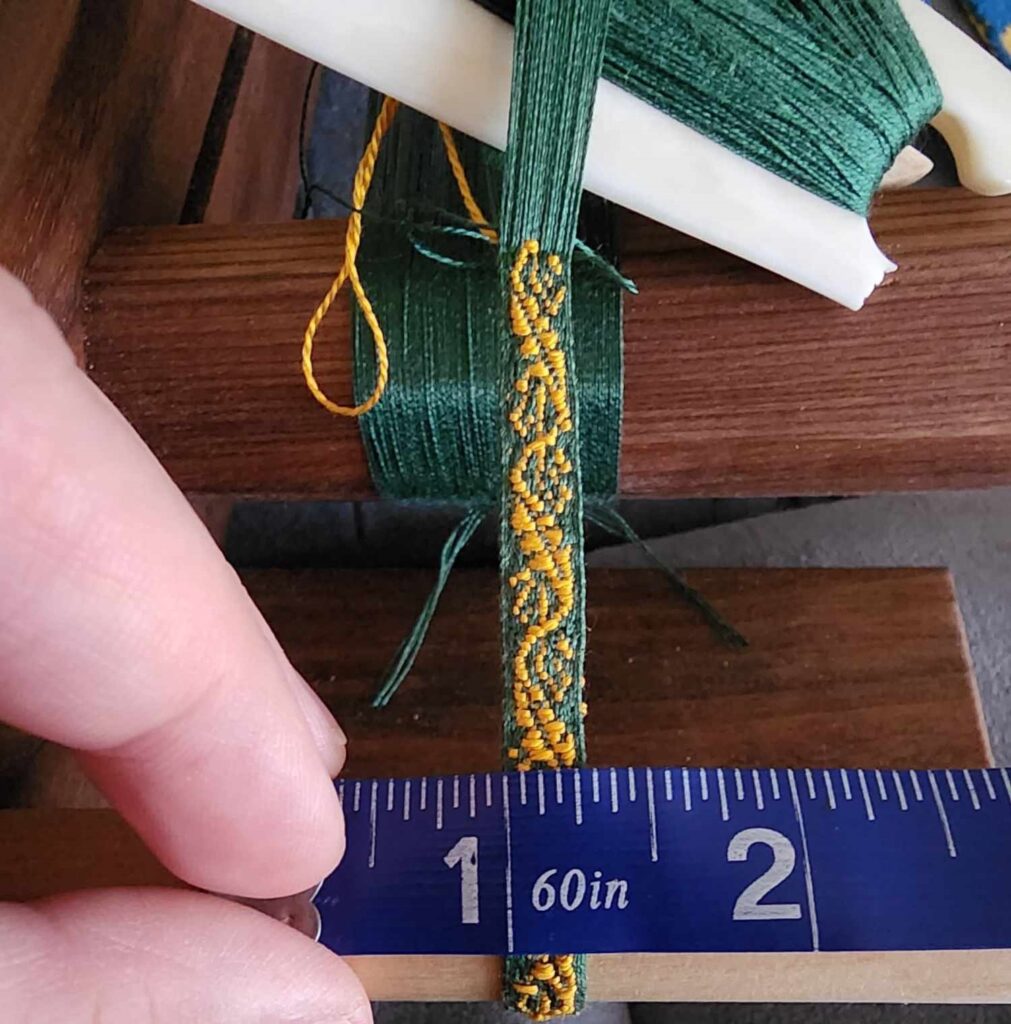
(Left. Picture of weaving in progress with measuring tape showing the band is only ¼” wide.)
What I would have changed:
The biggest thing that I would have changed if I had the power to change the space-time continuum, would be to start this project way earlier than I originally did. Remember how I mentioned that I only had about a yard woven at this point? It turns out that on top of brocade taking forever, the smaller the project is, the more complicated it gets and the longer it takes.
For reference, I started weaving this trim on November 1st and this competition is on December 9th. I had about a month to attempt to get 3 yards of brocade trim done. It wasn’t going to happen, especially not with Thanksgiving in the middle of it all. The main reason I started this project as late in the calendar as I did was due to issues acquiring my gold brocade thread that no one had any control over.
Other than timing issues, the only other thing I’d do differently would be to use a thicker thread for the ground weave or find some other way of making the pattern a bit wider. I don’t mind doing narrow bands, but it definitely was a challenge to work with and very hard to see what I was doing at times.
Conclusion: Like with every new technique I try for the first time, I learned a lot from this project! Brocade is a beautiful beast that requires lots of patience and proper time management. Not only was this my first time tablet weaving a brocade piece, but it was also my first time using 60/2 size silk. This is the thinnest thread I’ve worked with thus far and it was very exciting to see what I could do with it!
I can’t wait to finish all three yards of this trim as it will be going on a piece of garb for Orso eventually. (And to get to the next project!) As tedious as it is, this really is a great technique to learn, and I would encourage every tablet weaver out there to give it a shot at least once.
Acknowledgements:
- Orso Luca di la Licata for being my willing guinea pig and giving me the inspiration and opportunity to make this project happen! Honey, I love you and I’m so glad I can weave trim for your garb. I can’t wait to see what it looks like when you’re wearing it!
- Magnifica Arabella De Mere for being a huge help, pointing out some spots that needed a bit of brushing up, and introducing me to Maestra Ellisif! Without that introduction, this project would have never gotten off the ground as well as it did! Thank you so much!
- Tasha Medvedeva kennari for being an amazing editor who once again said yes when I asked for a second set of eyes on my documentation. I’m sorry in advance for all the work I’ve caused (again). You’re the best!
- Maestra Ellisif Gydasdottir for absolutely positively being the best source of advice on brocade tablet weaving I could have ever asked for! Not only did you direct me to a treasure trove of patterns in the period I needed, you were also there every step of the way from transcription to weaving to documentation. Thank you so very much! I didn’t just get another mentor, I got another weaving friend. And that means the world to me.
Bibliography:
Works Cited
Bargmann, Ute. “Textile Society of America 8th Biennial Symposium.” Woven Bands, Medicines and Recipes: Cod. Pal. Germ. 551. The Adventures, Provenance and Contents of a 15th Centur Enance and Contents of a 15th Century Manuscript Held at the Library of Heidelberg University in Germany, 2002, digitalcommons.unl.edu/tsaconf/372/. Accessed 29 Nov. 2023.
Cripps, Libby. “Cod Pal Germ 551 — Silk & Quill: Libby Cripps.” Silk & Quill: Libby Cripps, 21 November 2022, https://www.silkandquill.com/textiles/blog-post-title-four-6rram. Accessed 29 November 2023.
De Mere, Arabella. “Brocade Tablet Weaving Basics – Arabella De Mere.” Arabella De Mere, 31 July 2017, https://www.arabellademere.com/2017/07/31/brocade-tablet-weaving-basics/. Accessed 1 December 2023.
Finchingefeld, Elewys Of, director. Weave Along with Elewys, Ep. 32: Brocade Tablet Weaving, 3 Feb. 2023, youtu.be/JY3KibRfwP4?si=BeA8RXeEGY4jLw2o.
“Universitätsbibliothek Heidelberg, Cod. Pal. germ. 551 Anleitung zum Bortenweben ; Medizinische Rezeptsammlung ; Kochbücher (Bairisch-mitteldeutscher Grenzraum, I. 1471–1475 ; II. um 1475 ; III. 1450–1455).” Heidelberger historische Bestände – digital, https://doi.org/10.11588/diglit.2615. Accessed 29 November 2023.
